PRINCETON, NJ -- As the U.S. Supreme Court convenes Wednesday with recently sworn-in Justice Sonia Sotomayor on the bench, Gallup finds Americans broadly upbeat about the performance of the high court. Sixty-one percent of Americans approve and 28% disapprove of the job the Supreme Court is doing -- among the most positive ratings the court has received in the past decade.
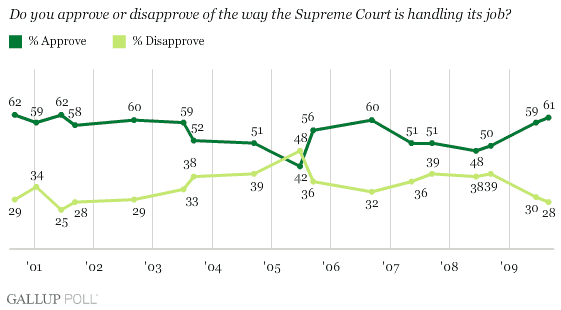
Overall views of the Supreme Court were nearly as positive as it concluded its last term in June. At that time, 59% of Americans approved of the court's job performance and 30% disapproved. However, approval was significantly lower in September 2008, when 50% approved and 39% disapproved.
"Aside from the increased approval of the court since September 2008, Gallup finds major partisan shifts beneath the surface."
As Gallup noted earlier this year, the improved ratings of the Supreme Court evident in 2009 are the result of surging approval from Democrats and slightly improved ratings from independents. Republicans' support for the court is lower than it was a year ago, but not by nearly as much as the increase seen among Democrats.
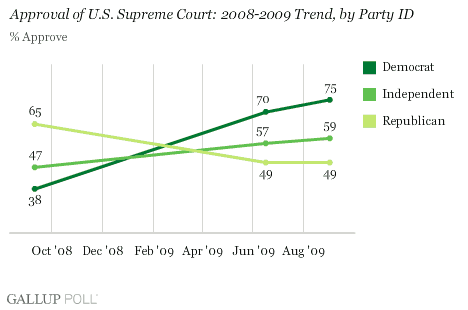
More Americans Content With Court's Ideological Tenor
The heightened public approval of the Supreme Court since last year is accompanied by a slight increase -- from 43% to 50% -- in the percentage of Americans saying the court is "about right" ideologically. That's a positive shift for the court, and represents an all-time high.
At the same time, Gallup finds a nearly complete reversal of the percentages saying the court is either "too liberal" or "too conservative." Today, 19% call the court too conservative, down from 30% in September 2008, while 28% call it too liberal, up from 21%.
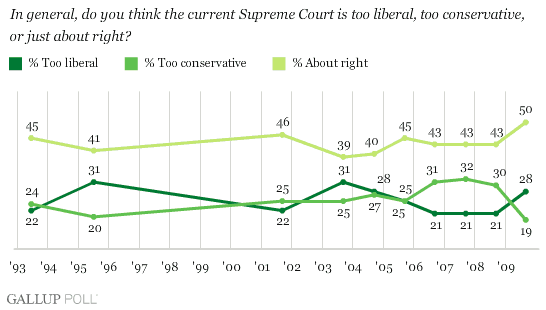
In the past year, both Republicans and independents have become more likely to say the Supreme Court is too liberal. For Republicans, this is now the dominant view (held by 49%), while independents remain most likely to believe the court is about right (46%).
By contrast, Gallup documents a substantial increase in Democratic contentment with the court's leanings. The majority of Democrats (59%) now say the court is about right, up from 34% in 2008. Since last September, the percentage of Democrats saying the court is too conservative has fallen from 50% to 30%.
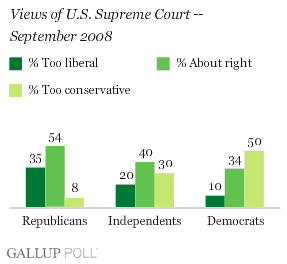

Bottom Line
Now that the political dust storm created by President Obama's nomination of Sotomayor is over, the Supreme Court heads into its 2009-2010 session with public support similar to its most positive ratings of the past decade. Americans who are inclined to perceive an ideological slant to the court are now more likely to consider the court too liberal than too conservative; however, fully half of Americans say the court is about right.
One reason public attitudes toward the court have improved over the past year could simply be that Americans are feeling more positive about government in general. In fact, Gallup approval ratings for the president, Congress, and the Supreme Court are all substantially higher today than they were a year ago, when President George W. Bush was still in office.
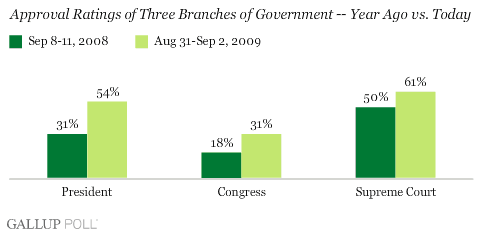
An absence of highly controversial Supreme Court decisions during the last term -- like those that created a backlash against the court in other years -- may also be a factor.
Aside from the increased approval of the court since September 2008, Gallup finds major partisan shifts beneath the surface. Democrats' support for the court has surged, Republicans' support has slumped, and independents continue to fall in the middle, albeit with a solid majority still approving.
Survey Methods
Results are based on telephone interviews with 1,026 national adults, aged 18 and older, conducted Aug. 31-Sept. 2, 2009. For results based on the total sample of national adults, one can say with 95% confidence that the maximum margin of sampling error is ±4 percentage points.
Interviews are conducted with respondents on land-line telephones (for respondents with a land-line telephone) and cellular phones (for respondents who are cell-phone only).
In addition to sampling error, question wording and practical difficulties in conducting surveys can introduce error or bias into the findings of public opinion polls.
